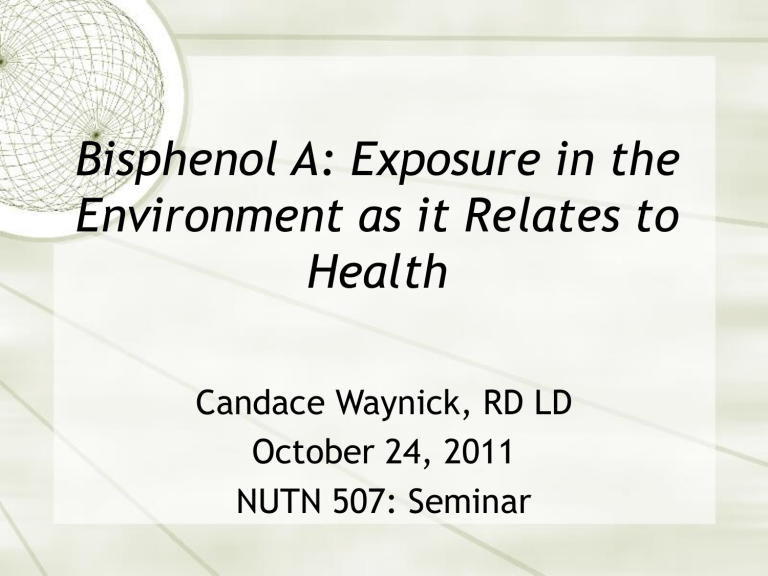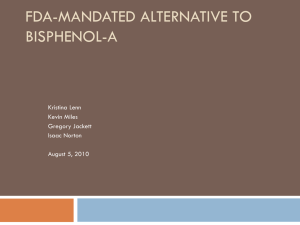Bisphenol A: Exposure in the Environment as it Relates to Health

Bisphenol A: Exposure in the
Environment as it Relates to
Health
Candace Waynick, RD LD
October 24, 2011
NUTN 507: Seminar
Objectives
Discuss the synthetic and legal history of
Bisphenol A (BPA)
Describe uses of BPA and BPA containing products
Discuss harmful effects of exposure to BPA and controversial methods of testing
Describe the role of dietitians to minimize public health risks associated with BPA
Synthetic History
2 phenol compounds and 1 acetone
Recognized for estrogenic properties in
1930’s by Edward Charles Dodd searching for the “mother substance” (synthetic estrogen)
In the 1950’s, BPA is used to synthesize epoxy resins and polycarbonate plastics
Superiority to glass and steel
Vogel 2009
Braun et al 2011
Biello 2008
Image: Wikipedia
Epoxy Resins
BPA is a monomer in synthesis
Products:
Protective coatings of medical equipment, piping, steel drums, and interior of food/beverage/liquid infant formula cans
Vogel 2009
Groff 2010
US FDA Update 2010
Taylor 2011
Image: http://news.consumerreports.org/a/6a00d83451e0d569e20120a69fcb0e970c-800wi
Polycarbonate (PC) plastics
Hard plastic formed when BPA is polymerized
Products:
Electronics, safety equipment, automobiles, food containers, plastics with recycling code # 7, intravenous tubing, dental sealant, reusable water and baby bottles
Vogel 2009
Groff 2010
US FDA Update 2010
Image: http://www.pacebutler.com/images/recycle/plastic-recycling-symbols-7.jpg
Thermal (Carbonless) Paper
Also contains BPA causing transdermal exposure
Products:
Sales receipts, cigarette filters, lottery tickets, fax paper, children’s books, and recycled paper products
Groff 2010
US EPA DRAFT 2011
Braun 2011
Taylor 2011
Image: http://www.bikudo.com/preview/292638.jpg
Leaching BPA
Monomers of BPA can hydrolyze and leach into foods or liquids
Accelerated by:
High temperatures
Acidic or basic conditions
Damaged surfaces
Le et al study
Exposure to
100
。
C (new and used PC water bottles) allowing 24 hrs to cool to room temperature
Results: 15-55 fold increase in those exposed to
Groff 2010 heat versus room temperature water only
Braun et al 2011
Biello 2008
Le 2008
Federal Regulation
1958- FDA approves BPA as indirect food additive
Safety determined by toxicity, not carcinogenicity
1977- National Cancer Institute (NCI) initiated 1st carcinogenesis study of BPA due to increased production
Responsibility of program passed to the National
Toxicology Program (NTP) during 2 year study
1988- Environmental Protection Agency (EPA) defines safe exposure levels to BPA as 50 micrograms/kg body weight
Vogel 2009
Shaw 2008
Health Implications
Endocrine system disruption
Cancer
Obesity
Cognitive and behavior impairment
Cardiovascular Disease
(CVD)
Type 2 Diabetes (DM2)
Asthma
Liver enzyme abnormalities
Shaw 2008
Ballard 2010
Image: http://bpafreewaterbottlespro.com/wp-content/uploads/2011/08/bpa-health-risks.jpg
Endocrine System Disruption
BPA is an endocrine-disrupting compound
(EDC)
An exogenous agent that interferes with synthesis, secretion, transport, metabolism, binding, action, or elimination of natural bloodborne hormones that are present in the body and are responsible for homeostasis, reproduction, and developmental processes.
Bourguignon et al 2010
Studies showing BPA as EDC
Moriyama et al (2002) show BPA inhibiting thyroid hormone receptor (T
3
)-mediated transcription by acting as an antagonist
Ramos et al (2003) exposed rats to BPA in utero indicating prenatal exposure induces transient and permanent age-dependent alterations in the male reproductive axis at different levels
Moriyama et al 2002
Ramos 2003
Image: http://electiondebates.com/images/stimulus-pix/rats.png
Studies showing BPA as EDC
Song et al (2002) demonstrate BPA inducing
NR4A1 gene expression (responsible for activating steroidogenesis) in mouse testicular cells
Akingbemi et al (2004) actually show the opposite with low doses of BPA showing an inhibitory effect on testicular steroidogenesis
Song et al 2002
Akingbemi et al 2004
Metabolic disturbances
Lang et al use NHANES data to show higher BPA urine levels associated with increased prevalence of CVD, DM2, and liver-enzyme abnormalities
Lang et al 2008
US EPA DRAFT 2011
Image: http://www.online-diabetes-information.com/wp-content/uploads/2011/03/diabetes-heart-disease2.jpg
Young children, infants, and fetuses at higher risk
Higher BPA concentrations reflective of higher food intake per pound of body mass
Predominant sources:
Fetus- shown to cross the placenta
Infants- breast milk, canned infant formula, and baby bottles
NICU infants exposed to higher levels due to intensive medical interventions
Children- canned food and beverages and school lunches
Groff 2010
Lang et al 2008
Bourguignon et al 2010
US EPA DRAFT 2011
Image: http://www.sequoiapediatricgroup.com/images/nicu_baby.gif
Exposure outcomes during development
Prenatal exposure associated with aggression and hyperactivity in 2 year old children
Delayed breast development with higher BPA concentrations
More sensitive to adverse outcomes due to exposure during development of neurological and endocrine systems
US EPA DRAFT 2011
Bourguignon et al 2010
US FDA Update 2010
Braun et al 2011
National Children’s Study
Started 2009
Examining fetal environment, including
BPA exposure
Following pregnant women and offspring until 21 years of age
Goal of 100,000 children participants
Largest, most comprehensive study of its kind in US
Groff 2010
Image: http://www.mrothery.co.uk/images/growth.gif
Metabolism
Oral ingestion of BPA is metabolized in the intestines and liver to yield metabolite, BPA monoglucuronide, and is excreted in the urine (in humans)
Acute exposure studies show:
rapid metabolism of BPA with urinary elimination to be within 24 hours of exposure based on 4-6 hour half-life
Stahlhut 2009
Lang et al 2008
Image: http://image3.examiner.com/images/blog/wysiwyg/image/water_bottle1(1).jpg
Metabolism Controversy
BPA monoglucuronide elimination:
humans/primates- from the blood via kidneys into urine
Rodents- bile excretion into feces
Current safety measured on belief that higher doses result in greater effects
If higher doses cause no harm, lower doses are deemed safe?
Groff 2010
Lang et al 2008
Taylor et al 2011
Studies Addressing
Controversy
Stahlhut et al suggest a longer than expected half life attributed to either environmental exposure or accumulation in adipose tissue
Taylor et al compare bioactive BPA
(unconjugated) levels in primates and rodents reporting clearance rates are the same
Stahlhut et al 2009
Taylor et al 2011
Groff 2010
Image: http://maxcdn.fooyoh.com/files/attach/images/3004/141/953/004/Monkey_facepalm.jpg
Exposure
Over 90% of U.S. individuals have measurable concentrations of BPA in their urine
Significantly higher levels of BPA in younger children, women, and incomes <
$45,000/year
1997-2005- 115 studies in US, Japan, and Europe show some effects at or below the reference dose
Braun et al 2011
Lang et al 2008
Groff 2010
Taylor 2011
Vogel 2009
Image: http://3.bp.blogspot.com/_xo0o9nT5MLI/TOq_bZElPYI/AAAAAAAAAB8/nQspiA_mtwY/s1600/MP900431826.JPG
Back to Federal Regulation
2007- Chapel Hill Consensus Statement
BPA, at concentrations found in the human body, is associated with “organizational changes in prostate, breast, testes, mammary glands, body size, brain structure and chemistry, and behavior of laboratory animals.”
2008- The Center for Evaluation of Risks to Human
Reproduction (CERHR) within the NTP released two statements regarding BPA at current exposure:
“some concern for effects on the brain, behavior, and prostate gland in fetuses, infants, and children”
“minimal concern for the effects on the mammary gland and an earlier age for puberty for females in fetuses, infants, and children”
Vogel 2009
US FDA Update 2010
Image: http://www.knowabouthealth.com/wp-content/uploads/2010/07/BPA.jpg
Current Regulation of BPA
January 2010- Food and Drug Administration announces it had some concern about BPA
November 2010- World Health Organization recommend holding off on regulations that limit or ban use of BPA
Several local and state governments in US have limited or banned use of BPA
Oregon Senate Bill: http://gov.oregonlive.com/bill/2011/SB695/
October 2011- American Chemistry Council asks to phase out allowance of BPA in baby products
US EPA 2010
Brown 2010
USA Today 2011
BPA-free Manufacturers
By March 2009, major baby bottle companies removed BPA from products
Sunoco requires written confirmation of BPA plastic not sold to children ≤ 3 years
2010- General Mills announced next tomato harvest, all Muir Glen tomatoes canned BPAfree
Vogel 2009
Szabo 2008
Eden Foods beans have been BPA free since
1999
USA Today 2011
Image: http://www.kidsbabydesign.com/wp-content/uploads/2009/06/bpa-free-baby-bottles.jpg
Image: http://www.greenbiz.com/sites/default/files/imagecache/wide_large/0410Muir.jpg
Minimizing Health Risks
Rudel et al conducted a study following participants measuring BPA at baseline and 3 days post intervention
(eliminating canned/packaged foods)
50-70% decrease in urinary BPA
Rudel et al 2011
Image: http://3.bp.blogspot.com/_4J97xRX7uok/TG4Bj2OHSII/AAAAAAAAAAk/DOb-TqhLJh0/s1600/Fresh+foods+vs+Canned+foods.png
Role of the Dietitian
Counsel public to:
Avoid canned foods
Replace recycling #s 3, 6, & 7 with other recycling #s (1, 2, 4, or 5), stainless steel, or glassware
Switch from liquid formula to powdered
Avoid heating BPA plastic
Replace canned foods with fresh or frozen foods
Discard scratched baby bottles/cups
Braun 2011
Only use dishwasher safe and microwave safe plastics in appliances
Groff 2010
Bourguignon 2010
US DHHS
Summary
BPA found in plastics (code # 7) and canned foods/beverages
Health implications include endocrine system disruption, risk of CVD, neurological impairments, obesity, DM2, and liver enzyme abnormalities
No federal limits or bans on uses
Dietitian can reduce public exposure by suggesting replacements
Discussion
Image: http://www.sneakerfiles.com/wp-content/uploads/2011/09/Discussion-The-Discussion.jpg






